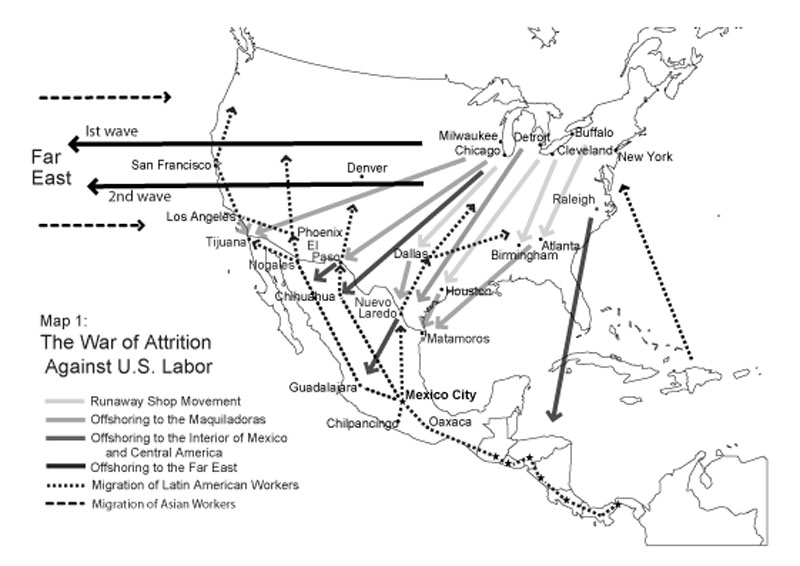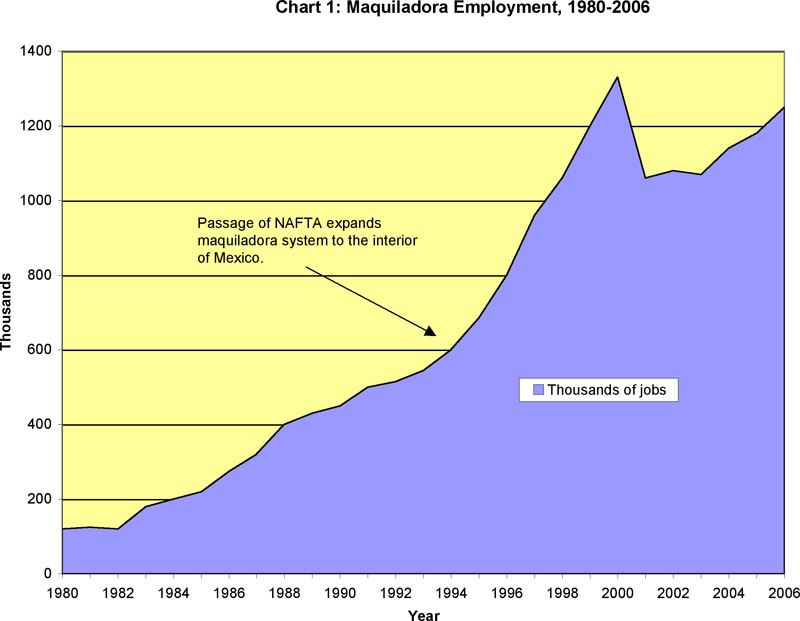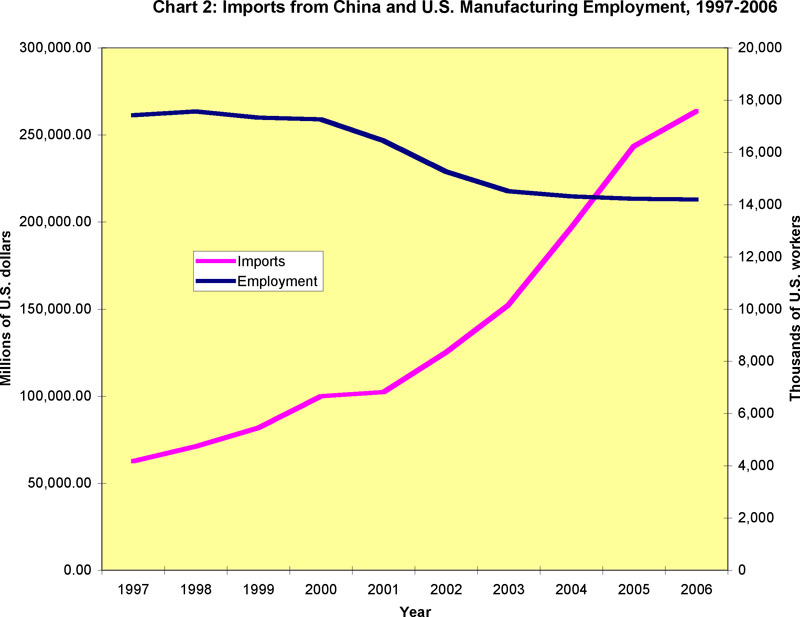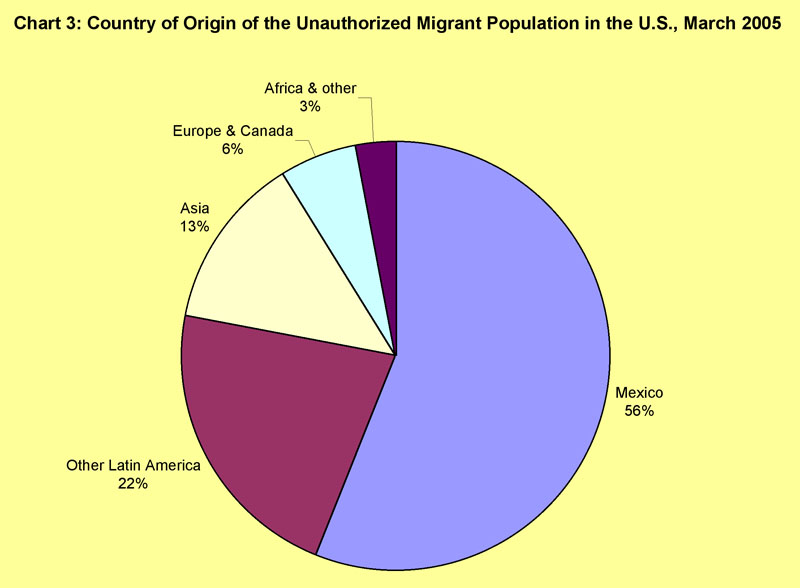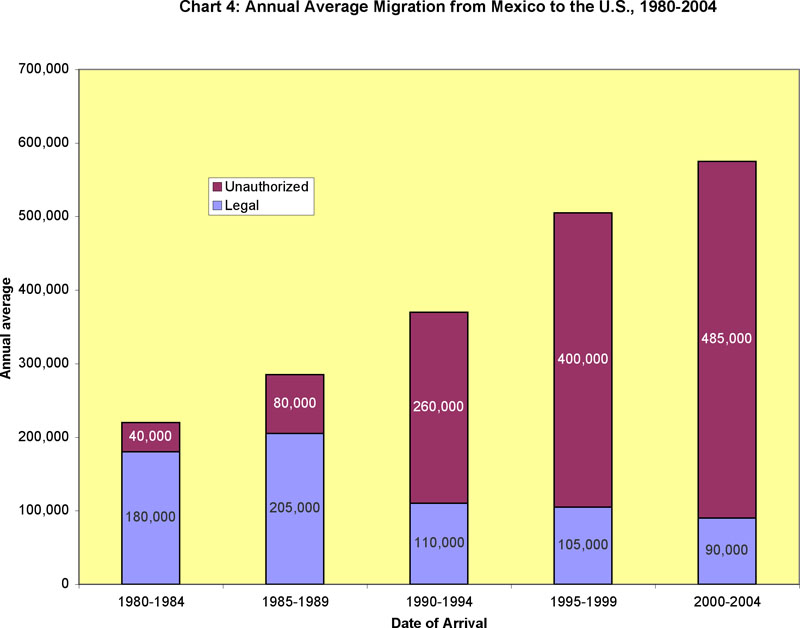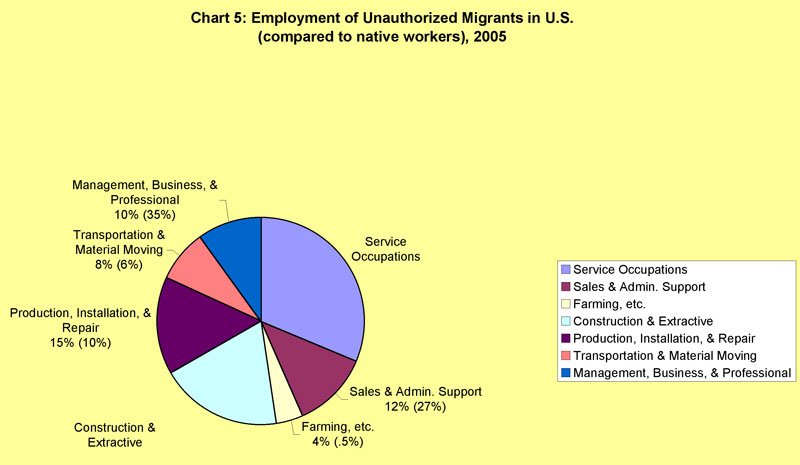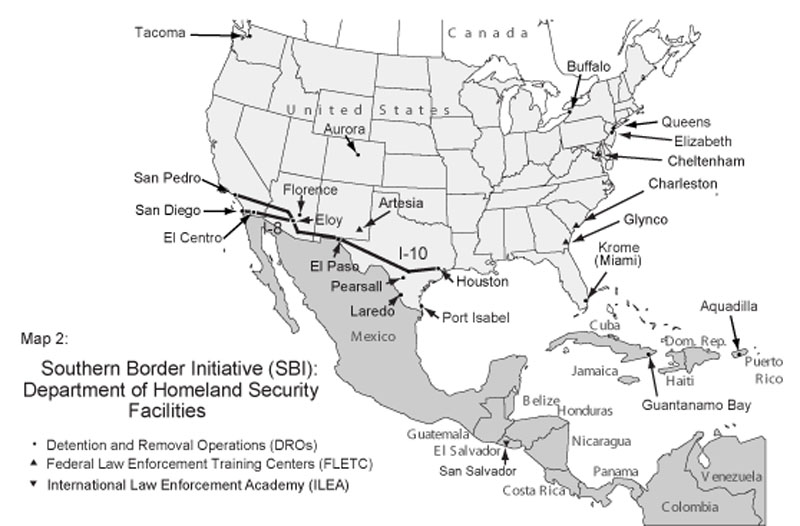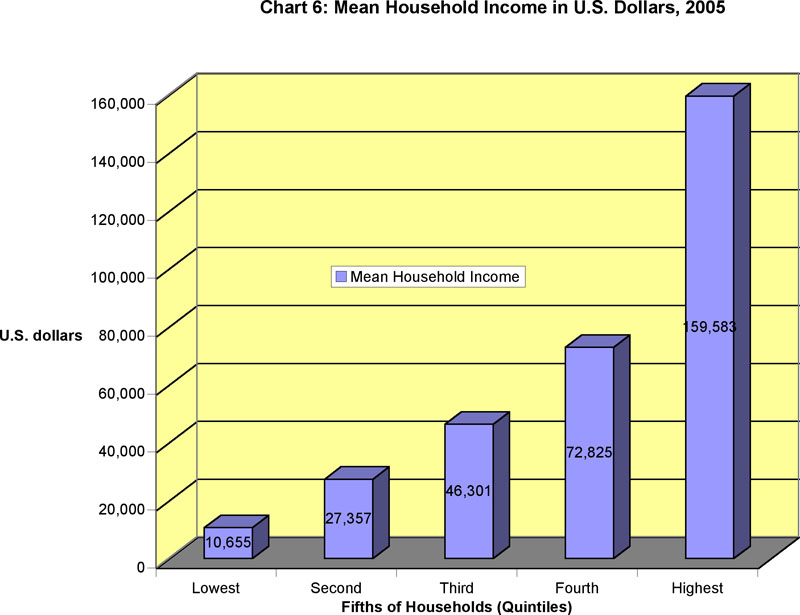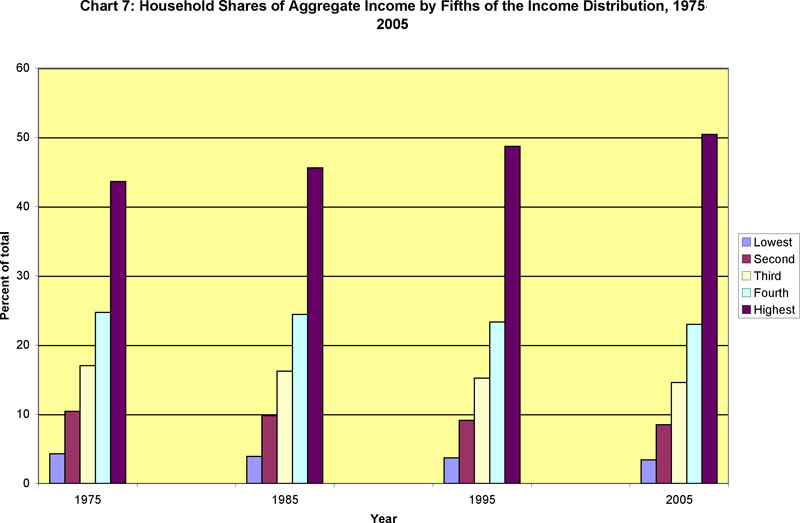1.
Introduction: The War
We are in the fight of our lives. The hostile onslaught against U.S. labor that was launched after the Second World War and redoubled in the 1980s is entering a new phase that will profoundly influence the future of all working people in North America. How we respond to this latest assault of capitalism might well prove to be the pivotal contest of modern times.
The iron law of capitalist production — the zero-sum relationship between profit and wages — is becoming more skewed every day. During the last half of the 20th century and the beginning of the 21st, U.S. capitalism consolidated its control of the existing political apparatus to maximize profits at the expense of the working people of this nation and abroad through a protracted war of attrition.
Map 1 summarizes the history of the conflict.
As shown in Map 1, the war began with the runaway shop movement of the 1950s and 1960s; moved across the southern U.S. border with the establishment of the maquiladora manufacturing system in 1965; spread to the interior of Mexico and Central America after the adoption of the North American Free Trade Agreement (NAFTA); scored a major victory through mass offshoring to the Far East; is currently entering a second wave of exporting technical, service, and professional jobs; and has returned to the home front with the mass employment of undocumented migrants and ongoing attempts to establish a national guest worker program.
Analyzing this crusade by reviewing its major campaigns is the best introduction to the present crisis of U.S. labor and indicates the direction that the struggle against U.S. capitalism must take.
2.
Declaring War: The Taft-Hartley Act of 1947
Labor law defines the rights and responsibilities of labor vis-à-vis capital in modern industrial nations, and, historically, labor legislation in the U.S. has promoted the interests of capital by severely restricting the power of working people to defend their vital interests.
The Taft-Hartley Act of 1947, the official declaration of war against U.S. labor, is still in force. Written and forced through Congress by the powerful National Association of Manufacturers, this legislation outlaws or restricts labor’s basic organizing tools.
Taft-Hartley imposes the following disabling provisions on labor. It:
- Allows courts, at the behest of capital, to issue injunctions prohibiting strikes. These injunctions can be enforced through a range of sanctions from fines to police and military intervention.
- Allows the government, at the behest of capital, to impose extended “cooling-off” periods on striking workers, giving employers time to weaken or break strikes.
- Prohibits organizational picketing, a fundamental organizing tool.
- Permits employers to hire scabs as permanent replacements for striking workers.
- Bans the use of union dues for political purposes.
- Bans secondary boycotts and sympathy and solidarity strikes in order to thwart working-class unity.
- Prohibits unions from expelling company spies as long as they pay their dues.
Although these provisions of the law paralyzed the organizing drives of the U.S. trade union movement, capital was unable to dislodge the deeply-rooted unions from the factories and communities of the Northeast and Midwest. It was another provision of Taft-Hartley which encouraged states to pass anti-union “right-to-work” laws that gave U.S. industry a way to avoid negotiating with organized workers.
3.
Running Away
Failing to defeat labor in the historic industrial centers of the nation, U.S. capital embraced a new strategy in the war of attrition — running away instead of negotiating with workers — a strategy that is still being pursued today.
The opening campaign of the new initiative was the state-sponsored runaway shop movement of the 1950s and 1960s.
The Opening Salvo: the Runaway Shop Movement
The runaway shop movement, represented on Map 1 by the light-colored arrows, was the opening salvo in the modern campaign against U.S. labor. The relocation of many manufacturing and heavy industries that began in the 1950s was the result of the flight of capital from the heavily unionized industrial centers of the Midwest and Northeast to the right-to-work states of the South and Southwest in search of cheaper labor. Many large corporations, supported and subsidized by local, state, and Federal agencies, moved operations from cities like Chicago, Buffalo, Cleveland, Detroit, Pittsburgh, and Milwaukee, to name only a few, to cities in the South and Southwest like Atlanta, Birmingham, Houston, and Dallas-Ft. Worth where capital avoided closed shops and profited handsomely from the racial strife and competition fostered between workers. The weak unions that did exist in the South and Southwest were either de jure or de facto segregated institutions with sliding wage scales that pitted white against black and Mexican-American labor and served the interests of capital far more than they did those of working people.
The runaway shop movement was a major blow to U.S. labor, resulting in the mass dislocation of workers in the Rust Belt and the collapse of entire communities. The cities of Detroit, Cleveland, Philadelphia, Buffalo, Akron, Syracuse, Youngstown, St. Louis, and many more, were devastated by the runaway shop movement and have not recovered to this day. Displaced workers who migrated south in the wake of the movement ended up competing with local workers in a depressed, pro-capital labor market. The migrants ended up sharing the low standards of living and expectations of their Southern counterparts.
The South did not remain the destination of capital for long. The U.S. civil rights movement, which triumphed in the mid-1960s, guaranteed equal pay for equal work and outlawed job discrimination, undermining capital’s privileged position in the South and Southwest. Always operating under the iron law of profit maximization through cheaper labor, U.S. capitalism began a campaign to recruit an offshore industrial army willing to work for less.
Recruiting an Offshore Industrial Army
Mexico was the logical target of initial U.S. offshoring schemes. The Mexican republic has been an indispensable source of cheap labor for capitalism in the North ever since the U.S. military conquest in the 19th century (see Richard D. Vogel, Stolen Birthright: The U.S. Conquest and Exploitation of the Mexican People). Historically, Mexican labor has played a vital role in the development of the southwestern States, and workers from south of the border have been exploited extensively, especially during the manpower shortages that have accompanied all of the major U.S. war mobilizations of the 20th century.
The termination in the mid-1960s of the bilateral Bracero Program that had been implemented to supply Mexican labor to U.S. agriculture during World War II and the subsequent mass deportation of the braceros, coupled with the widespread dislocation of workers in the weak Mexican economy, produced a reserve industrial army just south of the international border.
U.S. capitalism was quick to enlist this army of desperate Mexican workers and pit them against workers in the States.
Offshoring in North America: Maquiladora Manufacturing in Mexico
The Border Industrialization Program (BIP), developed and promoted by U.S. capital and ratified by both the U.S. and Mexican governments in 1965, established an offshore battle zone that remains a strategic front in the war of attrition against U.S. labor. The BIP granted foreign (primarily U.S.) industry almost unrestricted access to local labor in Mexico’s northern border states and guaranteed labor peace through company unions backed by armed force. The Mexican government sweetened the deal further by granting foreign firms exemptions from most taxation and environmental protection regulations.
U.S. capitalism has taken full advantage of the opening of Mexico.
The medium-colored arrows on Map 1 track the relocation of U.S. capital to the border industrial zone. These arrows reflect two distinct but related trends of U.S. offshoring to Mexico: the first migration of industries that relocated directly from the Rust Belt to south of the border and the second migration of industries that had been part of the initial runaway shop movement to the South and Southwest.
Offshoring to Mexico got off to a slow start but has become an important annex of U.S. capitalism.
Chart 1 chronicles the growth of maquiladora manufacturing in Mexico for the years 1980 through 2006 as measured by total employment. The chart shows that the growth of the maquiladoras, which had been relatively slow during the first 15 years of the program, took off abruptly in the 1980s. From the early 1980s to the early 1990s, maquiladora employment grew at a steady rate as many U.S. jobs were transferred to Mexico. The meteoric rise of maquiladora employment in the mid-1990s was a direct result of the adoption of NAFTA that allowed offshoring beyond the border industrial zone into the interior of Mexico.
The dark arrows on Map 1 reflect the deep penetration of U.S. capital into Mexico under NAFTA and the beginning of outsourcing work to Central America under various bilateral trade agreements with other countries.
Offshoring to Mexico, mostly from the U.S., boomed during the last half of the 1990s, and then dropped abruptly during the mild economic recession in the U.S. in 2001, indicating how closely these industries are linked to the U.S. economy.
Though many corporations have abandoned Mexico for even cheaper labor in the Far East, the maquiladora industries are currently experiencing a strong recovery as U.S. automakers and their suppliers shut down domestic production and transfer more work south of the border. Offshoring to Mexico has received an additional boost from unstable energy prices that threaten Far East supply chains and render Mexico more attractive because of its proximity to U.S. and Canadian markets.
Like the runaway shop movement, the maquiladora manufacturing system has been a major blow to U.S. labor and remains a point of contention. Although there have been some notable attempts at developing cross-border worker solidarity, offshoring to Mexico has been a successful campaign in the struggle to consolidate the power of capital over labor in the U.S.
The successful extension of the exploitation of offshore labor from the initial border industrial zone to all of Mexico through NAFTA has encouraged U.S. capital to expand its sphere of influence even further into the hemispheric South.
Conquering the Americas: CAFTA-DR, the FTAA, and NAFTA Plus
Central American and Caribbean labor is a primary target of the Central American Free Trade Agreement-Dominican Republic (CAFTA-DR), while the proposed Free Trade Area of the Americas (FTAA) is aimed at the nations of the hemispheric south. The ultimate goal of U.S. capital is to extend free trade policies to all of the countries in Central and South America and the Caribbean. Though Cuba is not currently on the official hit list, the U.S. beachhead at Guantanamo Bay indicates that post-Castro Cuba is also a prime target of U.S. free trade policy.
Growing opposition to the free trade movement that is gradually decimating all of the working people of the Americas has given rise to a new capitalist grand strategy that is being executed through the closeted trilateral Security and Prosperity Partnership (SPP) adopted by the U.S., Canada, and Mexico in 2005. Dubbed “NAFTA Plus” by pundits in the popular press, the SPP is a plan to sidestep grassroots opposition to free trade in North America by advancing the agenda of big capital through executive actions authorized by national legislatures. In the States these executive actions are carried out under fast-track authority granted to the President by the U.S. Congress.
Among the major goals of the SPP is the implementation of a mass guest worker program to export laborers from Mexico and Central America to the North. This latest campaign in the war of attrition against U.S. labor will be discussed in section 5.
As successful as the offshoring campaign against U.S. labor has been in the Americas, it is eclipsed by the devastating effects of exporting work to the Far East.
4.
The Global Assault: Offshoring to the Far East
Nobody knows the total number of American jobs lost by offshoring to the Far East, but its impact on the U.S. workforce has been ruinous.
The parallel black arrows on Map 1, which represent the trends of exporting jobs to the Far East, signify the most elaborate and extensive assault that has ever been launched against working people in the history of the world. Under the banner of the free market catchword globalization, U.S. capitalism has conducted a campaign to recruit an offshore industrial army in the Far East to decisively and permanently undercut labor in North America. Although offshoring to the Far East began during the reconstruction of Japan and the development of Taiwan in the post-World War II era and extended into Asia with the U.S. invasion and occupation of Korea, the key event was the opening of China to U.S. economic penetration in the late 1980s.
The dual black arrows on Map 1 symbolize the two clearly definable waves of offshoring to the Far East: the first wave of exporting manufacturing jobs that took-off in earnest during the 1990s which is still gaining momentum, and the second wave of outsourcing U.S. white-collar jobs to the Far East that is just getting underway.
The First Wave: Offshoring Blue-collar Work to the Far East
There is no single, authoritative source on the number of U.S. jobs that have been lost to countries in the Far East. Though the Bureau of Labor Statistics (BLS) is currently tracking U.S job losses due to factory closures and foreign relocations, the annual survey totally ignores the fact that the vast majority of new manufacturing jobs are being created by offshore expansions and start-ups, primarily in China.
However, meaningful estimates of job losses to China are made possible by examining the trends of trade with China and U.S. manufacturing employment.
Chart 2 tracks the imports of goods from China and manufacturing employment trends in the U.S. from 1997 through 2006. The trends are clear and uninterrupted throughout the period — manufacturing jobs in the U.S. have steadily declined while the import of manufactured goods from China has skyrocketed. These trends disclose that the economic recovery that began in 2002 was not a “jobless” recovery, as touted by government economists, but a reprieve for capitalism based on the creation of new jobs in China and the expansion of credit spending in the U.S.
The employment data reported in Chart 2, some of the most accurate information that BLS has ever published, suggests that a minimum of 3.2 million U.S. manufacturing jobs were lost to offshoring during the last ten years. These figures represent an 18.5 percent overall decline in a single decade. Though the deteriorating employment trend recorded in Chart 2 includes jobs lost to all regions, China accounts for most of them, and it is most certainly a gross undercount of lost jobs for the reasons stated above.
The impact of exporting blue-collar jobs to the Far East on U.S. labor far overshadows the damage inflicted by the runaway shop movement and offshoring in the Americas — and the war is far from over. The devastation wrought on the blue-collar workforce by the first wave of offshoring to the Far East foreshadows a comparable impact on the U.S. white-collar workforce as the second wave gathers momentum.
The Second Wave: Offshoring White-collar Work to the Far East
The offshoring of white-collar work to the Far East is even harder to assess than the exporting of blue-collar jobs because of the comparative ease of foreign start-ups and the virtually unregulated technology-based import of the finished products. Presently, the white-collar jobs being outsourced, in this case primarily to India because of its large, well-educated, English-speaking population, include: information technology work; customer service occupations; back-office and data-processing jobs; and increasingly, professional and paraprofessional services (research and development, engineering, legal, medical, commercial art, etc.). This second wave of exporting jobs is off to a much faster start than that of the first wave.
In a compelling article published in Far Eastern Economic Review entitled “The Next Wave of Offshoring,” Robyn Meredith explores the future of exporting white-collar work to the Far East. The initial forecast for this second wave, based on BLS and industry sources, is foreboding; as of 2005 at least 500,000 white-collar jobs had already been transferred to the Far East with a projected total of 3.3 million by the year 2015.
The impact of white-collar offshoring on U.S. workers promises to be exacting; while 30 percent of the displaced workers will find new jobs and be no worse off than before they were laid off, over half will have to take pay cuts of at least 15 percent, and a fifth of them will have to bear income reductions of at least 30 percent. As in the case of blue-collar offshoring, overseas start-ups and new hires will far outnumber the export of existing jobs. With Asian wages currently at one half to one fifth those of U.S. workers, many American companies no longer bother recruiting onshore.
The educational level of the workforce is a major factor in white-collar outsourcing. Currently, China and India combined produce 4 million college graduates a year, twice as many as the total for the U.S. and Europe, and, by all accounts, the technical education available at the Indian Institutes of Technology is superior to that offered in the West. To support education, the Indian government has committed 6 percent of the nation’s annual gross domestic product, while the West is currently investing tens of millions of dollars to upgrade universities in China.
India and China aren’t the only countries in the Far East supplying white-collar labor. The governments of both Malaysia and the Philippines, each with large English-speaking populations, have offered up their workforces to foreign employers.
U.S. labor has been trumped again. In the past two decades, many U.S. hourly workers responded to the export of traditional blue-collar occupations by sacrificing to get their children through college and steering them toward supposedly safe service-sector jobs. Today many of these children who are in the workforce now are watching their jobs follow those of their parents. The significant difference this time is that nothing is being offered except long-term under- or unemployment that will be aggravated by the ongoing campaign of U.S. capitalism to recruit a cheap onshore industrial army.
5.
Return to the Home Front:
Recruiting a Cheap Onshore Industrial Army
At the same time that elaborate offshoring schemes have been employed to undermine labor in the U.S., a nationwide drive to establish a cheap onshore industrial army has also been launched. The initial action of this offensive is the mass employment of undocumented migrant workers inside the U.S.
The Mass Employment of Undocumented Workers in the U.S.
Though U.S. capitalism has historically extracted enormous super-profits from immigrant labor, the present state of affairs is unprecedented because of the magnitude of recent migration and the preponderance of the undocumented among the migrants (the dashed arrows on Map 1 follow the main paths of current unauthorized migration to the U.S.).
This recent flood of undocumented workers now constitutes a significant sector of the U.S. workforce. Current estimates of the unauthorized immigrants living and working in the nation range between 12 and 15 million. A demographic profile of this population is necessary to understand the current labor crisis in the U.S.
Chart 3 identifies the contemporary unauthorized migrant population that reside and work in the U.S. by country of origin.
Chart 3 indicates that only 13 percent of the total (about 1.5 million) of the unauthorized migrants came from Asia, while 78 percent (about 8.7 million) migrated from Mexico and other Latin American countries. While the preponderance of unauthorized migrants from the hemispheric South establishes the geopolitical dimensions of the current U.S. labor crisis, it is also important to note the change in the legal status of this target population.
The trends of both legal and unauthorized migration from Mexico, by far the leading country of origin, are summarized in Chart 4.
Chart 4, which shows the date of arrival and legal status of migrants from Mexico to the U.S. since 1980, highlights the accelerating momentum of the undocumented migration.
Although the overall trend shows steadily increasing numbers of migrants, the most remarkable feature of Chart 4 is the escalating proportion of unauthorized migrants as compared to those who arrive in the U.S. legally. The recent boom of unauthorized migration started in the beginning of the 1990s and has accelerated ever since with 66 percent of the total (7.3 million) arriving in the last ten years.
How this army of unauthorized workers is employed in the U.S. economy discloses a key issue of the U.S. labor crisis today. The employment of these undocumented workers is broken down by economic sector in Chart 5.
Chart 5 illustrates how widely unauthorized migrant labor is exploited in the U.S. economy. Significantly, 78 percent of these workers are concentrated in low-wage and casual employment in the U.S. compared to 39 percent of native workers. It is imperative to note that only 4 percent of these workers are employed in farm work, while 74 percent of them are employed in service, construction, and transportation jobs — proportions that signal a radical expansion of the role of Mexican and Central American labor in the U.S. economy.
The demographic and employment profiles of the contemporary unauthorized migrant population present a comprehensive picture of the onshore industrial army in the U.S. that capitalism is currently exploiting as undocumented workers and is seeking to capture as transient servants under a national guest worker program that will legalize their exploitation and undermine native labor even further.
The Pending Guest Worker Program: Transient Servitude in the U.S.
The goal of the pending U.S. guest worker legislation is to draft a majority of the undocumented migrants presently living and working in the U.S. and channel new economic immigrants into a program of transient servitude that will insure U.S. capitalism a steady onshore supply of cheap workers without legal protection and subject to deportation when their labor is no longer needed (for a detailed discussion of the pending U.S. guest worker program, see Richard D. Vogel, “Transient Servitude: The U.S. Guest Worker Program for Exploiting Mexican and Central American Workers”).
The infrastructure needed to control the massive flow of human traffic resulting from the pending guest worker program is already in place or under development. The heart of the transportation system will be the two colossal NAFTA supercorridors that are presently under construction: the I-35 corridor that will span the nation from Laredo, Texas to Duluth, Minnesota, and I-69 which will extend from Laredo to Port Huron, Michigan. These corridors, which are being developed as private toll roads, will transport millions of transient servants throughout the nation as well as distribute goods produced in the maquiladoras and commodities manufactured in the Far East and land-bridged across Mexico.
The ongoing expansion of the enforcement infrastructure to accommodate the guest worker program is being conducted as the Southern Border Initiative (SBI) under the auspices of the U.S. Department of Homeland Security (DHS).
Map 2 locates the existing detention and training facilities of the SBI and the DHS.
Map 2 shows that while the main front of the SBI is a an east-west line that extends from Houston to San Diego, there are also several Detention and Removal Operations facilities (DROs) strategically placed to process guest workers from Central America and the Caribbean. The scope, scale, and positioning of the SBI network dispels any doubts about its ultimate purpose.
The adoption and implementation of a national guest worker program that will import millions of desperate workers from Mexico, Central America, the Caribbean, and Asia into the U.S. as transient servants will be yet another victory for U.S. capitalism vis-à-vis all working people in the Americas. Under intense pressure from powerful business interests, the 110th U.S. Congress is set to rubber stamp a guest worker program at the conclusion of its current deliberations on comprehensive immigration reform.
Stopping the adoption of transient servitude as national policy promises to be a key battle in the ongoing war of attrition against U.S. labor. It is, however, only one front in the struggle that promises to be the fight of out lives.
6.
The Fight of Our Lives
Since the end of World War II, and especially since the 1980s, U.S. capitalism has enjoyed an unprecedented glut of profits from direct-labor savings produced by the run-away shop movement and various successful offshoring and onshoring schemes. The deepening social stratification produced by the growing imbalance of power is now irrefutable, and the consequences are undeniable.
The Costs of the War
The economic costs of the war of attrition against working people have been heavy and are continuing to mount. At the behest of business interests, the U.S. Census Bureau keeps a close eye on the distribution of income in the nation.
Chart 6, based on Census Bureau reports, presents a stark portrait of the current extremes of economic stratification in the U.S. in terms of income.
The economic disparity in the U.S. illustrated in Chart 6 is appalling. The fact that the lowest fifth of U.S. households receives less that 7 percent of the income of the highest fifth doesn’t tell the whole story; because of the regressive tax and market structures in the U.S., the real income of poor households was far lower than the $10,655 reported in 2005. Both the number and proportion of U.S. families living in poverty are the highest in modern U.S. history.
The comparison of the income levels of the middle classes to the highest is as telling as the contrast of the extremes. The fact that the combined mean incomes of the lowest, second, third, and fourth quintiles of U.S. households (80 percent of all households) falls short of the mean income of the highest 20 percent is stark testimony to the diminished middle classes of America.
The U.S. Census Bureau also tracks changes in the nation’s income distribution. These findings are displayed in Chart 7.
Chart 7, which completes the portrait of inequality outlined in chart 6, records the increasing social stratification of the U.S. It shows that while the share of aggregate income going to the top 20 percent of U.S. households has risen steadily over the last 25 years and now exceeds 50 percent of the total, the shares of all other households, most notably the middle classes, have decreased correspondingly.
Taken together, charts 6 and 7 dispel any lingering myths about economic equality or equal opportunity in the United States.
The dire consequences of social stratification for the working people of the U.S. follow their declining economic fortunes. As real wages decline and the cost of living continues to rise, working people are laboring longer and harder for increasingly less. Quality housing, education, and health care are becoming less affordable, and credit spending, the stopgap of contemporary capitalism, is mortgaging the future of working class families and their children.
As tax revenues in working class communities decline, the social infrastructures of those communities deteriorate — public schools are starved of funds and education is privatized, public health programs are restricted or discontinued, and the funding for disability and old age pensions dries up. In the end, market relationships displace social relationships, and those who cannot pay cannot thrive.
The concentration of income and wealth and all of its social consequences are the spoils of the war of attrition on U.S. labor, and, unchallenged, these devastating trends will continue.
It is clearly time to fight back and how to do it effectively becomes the burning question of our times.
Fighting Back
The war of attrition against U.S. labor has been successful to date — U.S. capitalism has consolidated its political hold on the state and enjoys almost complete hegemony.
It is clear that only the working people of the United States can defend their own interests. It is equally clear that we must either fight back or sink even lower.
Fortunately, the history of the conflict and the deteriorating social and economic conditions of working people in the U.S. reveal some of the ways and means for labor to defend itself.
The defense of labor calls for the following measures:
- Repeal all anti-labor legislation. Only organized labor can put an end to the widespread exploitation of workers at home and abroad and must be freed from the onerous restrictions imposed by capital in order to do so. Replacing all anti-labor legislators, judges, and bureaucrats is a prime corollary of this measure. Furthermore, the international nature of modern production necessitates an international approach to the defense of labor. This can be done through the application and enforcement of the ILO “International Labor Standards” at home and abroad.
- End all U.S. government incentives and guarantees for capitalism’s offshoring and onshoring schemes. This demand includes opposing the pending national guest worker program. Working people simply cannot allow transient servitude in the United States. Immigration policy must embrace the principle that if people are good enough to work in the U.S., they are good enough to stay in the U.S. The focus of government economic policy must be shifted from short-term profit maximization to full employment and sustainable economic growth.
- Provide equal education that strengthens our national workforce by preparing our youth to be effective workers and citizens. Historically a local prerogative, public education in the U.S. must be redefined as a national priority.
- Establish a quality universal health care system to maintain the vitality of the U.S. workforce and their families, as well as retired workers. Ignoring health care needs is simply unacceptable in modern society.
- Build and maintain an adequate social safety net for all working people in the U.S. This measure includes the preservation and improvement of existing social security programs and the creation of new programs, as they are needed.
The history of the war of attrition against U.S. labor establishes one irrefutable truth — whether we want to face it or not, we are in the fight of our lives.
Richard D. Vogel is a political reporter who monitors the effects of globalization on working people and their communities. Other works include: “The NAFTA Corridors: Offshoring U.S. Transportation Jobs to Mexico” and “Transient Servitude: The U.S. Guest Worker Program for Exploiting Mexican and Central American Workers.” Contact: [email protected].
|
| Print

